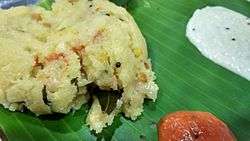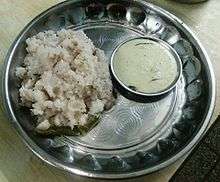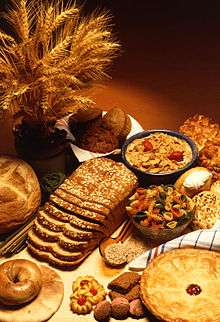Upma
 Upma | |
| Alternative names | Uppuma, Uppittu, Uppumavu, Uppindi, Kharabath, Upeet, Rulanv |
|---|---|
| Course | Breakfast |
| Place of origin | India |
| Region or state | South India, Western India |
| Main ingredients | Wheat rava (semolina) or coarse rice flour. |
Upma, uppumavu or uppittu is a dish originating from the Indian subcontinent, most common in South Indian,[1] Maharashtrian, and Sri Lankan Tamil breakfast; cooked as a thick porridge from dry roasted semolina or coarse rice flour.[2] Various seasonings and/or vegetables are often added during the cooking, depending on individual preferences. Today it is popular in most parts of India and is prepared in various ways.
Etymology
In many Dravidian languages, the word uppu means salt and pindi, mavu or hittu means flour, hence the name uppindi, uppumavu or uppittu. In North India, it is called upma.
| Language | Roman Transliteration | Native Unicode |
|---|---|---|
| Kannada | Uppittu, Kharabath | ಉಪ್ಪಿಟ್ಟು, ಖಾರಬಾತ್ |
| Tamil | Uppumavu, Uppuma, Upma | உப்புமா |
| Telugu | Uppindi, Upma | ఉప్మా, ఉప్పిండి |
| Malayalam | Uppumavu | ഉപ്പുമാവ് |
| Marathi | Uppeet, Upma | उप्पीट/उपमा |
| Konkani | Rulanv | रुलांव |
| Hindi | Upma | उपमा |
| Odia | Upma | ଉପମା |
| Bengali | Upma | উপমা |
| Nutritional value per 120 gm | |
|---|---|
| Energy | 1,046 kJ (250 kcal) |
|
45.67 | |
| Dietary fiber | 3.2 g |
|
3.78 | |
| Saturated | 0.916 g |
| Monounsaturated | 1.54 g |
| Polyunsaturated | 0.944 g |
|
8.11 | |
| Minerals | Quantity %DV† |
| Potassium |
5% 223 mg |
| Sodium |
13% 190 mg |
|
| |
| |
| †Percentages are roughly approximated using US recommendations for adults. | |
Preparation
Upma is usually made with semolina (called rava or suji in India). The very basic method involves lightly dry-roasting the rava and mixing it thoroughly with a little salt and some boiling-hot water. There are many ways upma is prepared; indeed, every upma cook usually will incorporate variations in flavour when making upma. This variation is obtained by varying or emphasizing particular spices. A typical recipe includes:
Ingredients
- Semolina (rava) (1 cup)
- Cooking oil (3–4 tbsp)
- Mustard seeds (½ tsp)
- Cumin (1 tsp)
- Asafoetida (pinch)
- Curry leaves
- Chopped onions (1 med, chopped)
- Salt to taste
- Vegetables of choice: Peas, carrot
- Grated coconut (3–4 tbsp, optional)
- Lemon juice (2 tsp, optional)
Method of preparation
- Dry-roast Semolina (rava) until it just begins to turn brown, then keep aside.
- In a large saucepan/wok, heat the cooking oil.
- Add mustard seeds and wait for them to sputter. Then add cumin, asafoetida, ginger, green chilies, and chopped onions, and fry until onions caramelize.
- Add vegetables, salt and 2 cups of water, and bring to boil.
- Add the roasted rava, turn down the heat, and mix quickly to avoid lumps forming.
- The upma is cooked when all the water is absorbed by the rava.
- Garnish with grated coconut, chopped cilantro leaves and lemon juice.
Major variations
Sooji upma
The most popular version with wide variations of upma are made with whole or refined ground wheat and rice of varied grain size, Vermicelli. Sometimes a wide range of vegetables may be added, and may be garnished with a variety of beans (raw or sprouted), cashew and peanuts. For a variation called masala upma (known as 'Kharabath' in Karnataka), sambar masala or garam masala is added along with red chilli powder, instead of green chillies. This variety is more popular in Karnataka, Maharastra, Tamil Nadu and parts of Andhra Pradesh and is usually served in South Indian restaurants.
Whole wheat upma
Whole wheat or wheat dalia (cracked wheat) is known for its nutritional benefits. In Tamil Nadu Samba Wheat rava (Traditional Wheat) is used and is very popular in Coimbatore region where it is had as breakfast or dinner. Usually eaten with Banana and Ghee or Curd and pickle and also served with chutney and sambhar. Some times cooked with vegetables like peas, carrots, and beans for a fulfilling meal.
Rice upma

The rice upma, which is mainly popular in Tamil Nadu and southern parts of Karnataka is referred to as Akki Tari Uppittu (Rice coarse flour uppittu). Another variant of upma is prepared with grated coconuts instead of onions, especially on holy days, when onion is avoided. This type of upma is generally smeared with ghee at the end of preparation. Dishes similar to upma can be made by substituting small crumbs of leftover bread or Idli instead of flour. Upma made from coarser rava known as Sajjige is a dish of Udupi cuisine. It is sometimes served along with snacks such as sauted and spiced poha or Chevdo.
Corn upma

Another variation is corn upma which serves as a healthy breakfast due to the ingredients like corn, milk and nuts, curry leaves are added for flavour.[3]
Kesari bath
In Karnataka, upma is also served with another common sweet dish of Karnataka, kesari bhath (ಕೇಸರಿ ಬಾತ್), with a scoop of each on one plate, in a presentation commonly called "chow chow bath".
Aval upma/atukulu upma
In Andhra Pradesh, upma made with flattened rice in place of semolina is called atukulu upma (అటుకులు ఉప్మా). This variant is also known as aval upma in the Chennai region when made with rice flakes similar to poha.
Vermicelli upma

A popular light evening snack is upma made with vermicelli and tomato, peas and carrot.
Upma served with ghugni
In most parts of Odisha, a popular breakfast consists of sooji upma served with ghugni.
See also
- List of porridges
- Broken rice
- Couscous

References
- ↑ Pandya, M. (1985). Indian Vegetarian Cooking. Inner Traditions/Bear. p. 164. ISBN 978-0-89281-342-1. Retrieved January 26, 2018.
- ↑ "Poha or upma? Shabana Azmi and Twitter divided over breakfast dish". Hindustan Times. October 9, 2017.
- ↑ Dalal, Tarla. Healthy breakfast. Mumbai: Sanjay. p. 9. ISBN 9788186469811.
External links
| Wikimedia Commons has media related to Upma. |



